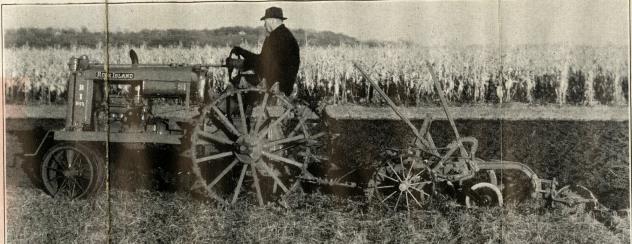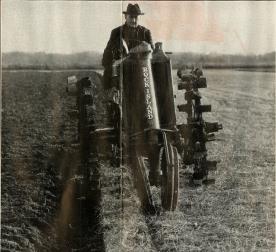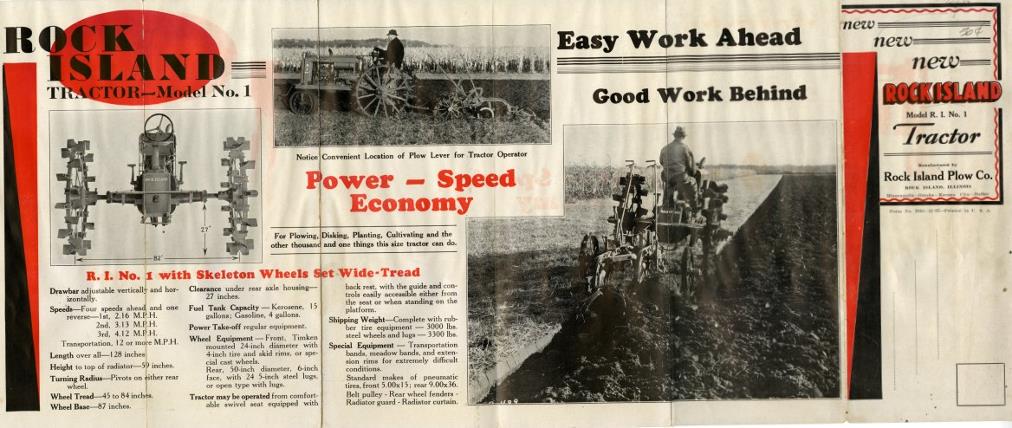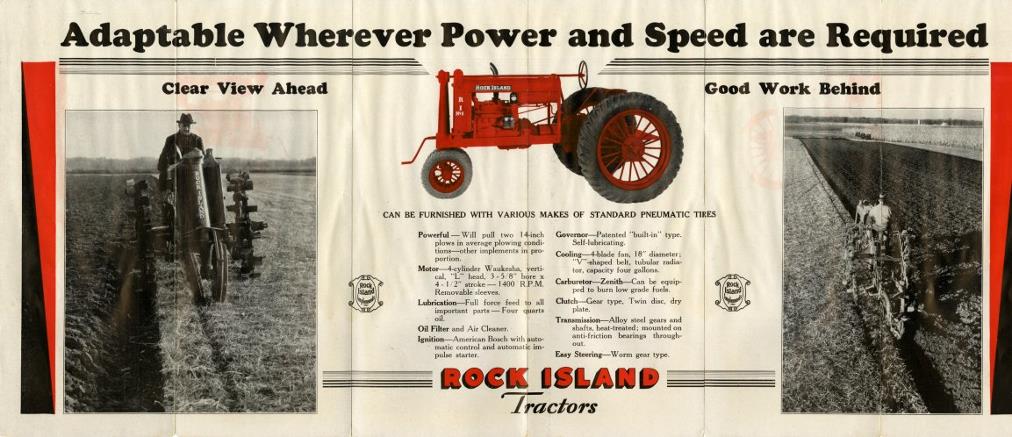






|
The Rock Island No. 1 was an experimental row crop design that appeared to be closely modeled on the Farmall F12 and F14. Seven tractors were reportedly built and put through trials, but were recalled to the factory and scrapped in the final days of the company. Four of these tractors were supposedly sold from the scrappers back into the wild, and at least one was kept at the plant into the 40’s by case, though its fate was probably the scrappers. One is currently known to exist in unrestored condition in Iowa with parts from out east from a probably different tractor.
The No. 1 could actually have been considered more then experimental, in that it appears advertising was already in distribution when the decision to scrap the project was made. Although fairly rare, I know of multiple copies of the glossy color No.1 brochure in circulation.
I have obtained copies of some internal correspondence that indicates the No 1’s were on trials in the field by late 1935 and were considered a great success with a handful of minor defects found and corrected. A new plow was in the works to match with it, along with a cultivator and a pull behind planter as part of the package, both adapted from horse drawn models. In early 1936 there were requests from the branch houses and salesmen for the No. 1; but the board had already gone into shut down, expecting to finish up production in February 1936. Further correspondence showed that even into early June General Manager Ed Weir still believed the company was operational and the release the tractor in the fall of 36 was still planned, viable and potentially profitable, much to the surprise of the Weyerhaeuser's.
Had the No. 1 gone into production, it would have been a major shift in design philosophy for the company. Pneumatic rubber tires would have been offered as standard as well as it being its first row crop design with integrated PTO and 4 speed transmission. A late generation 3 5/8 x 4 1/2 Waukesha 4 cylinder engine and a liter weight gave it better horsepower for its size. One other major departure was purely cosmetic, the traditional grey/red was replaced with a pure red design, further mimicking the look of the Farmall.
Although only a 2 plow rating is given, some guesses can possibly be made on the engine. The Waukesha XAH matches bore and stroke for 186 ci. The early Farmall f-12 only had a 113 ci Waukesha and was rated a weak 2 plow 13-15(16) hp. The larger F-20 with a 3 3/4 x 5 220.9 ci engine made roughly 20-28hp meaning the No.1 should fall in between these ratings.
Furthermore, the Allis WC used the XAH in the first 25 or 28 WC’s produced. Although a couple of examples of these early WC’s do still exist, no solid HP rating for these is given. The first WC Nebraska test in 1934 using the Allis engine with 201 ci places it as a 14-21 on steel and a 19-21 on rubber weighing in ~3200 lbs. These numbers are probably a fair ball park for where the No. 1 might have fallen.
Another piece of interesting information comes from Erb and Brumbaugh’s “Full Steam Ahead”. The demand for a small tractor resulted in the new Case Rock Island Plant to be given the lead on the development of the V series. During the prototyping of the V series, Case President Leon R Clausen, according to Erb and Brumbaugh, asked plant manager at Rock Island Ted Stahl if anything from the Rock Island line could be of use. Stahl responded December 19 1939 “When you were last here you suggested we review the Rock Island Plow Company tractors to determine if there is anything in these worth preserving for the V series line. We have had one of these tractors and the cultivator brought into the plant and we have set it up and reviewed it carefully. There is little if anything in either the tractor or cultivator the could be used to advantage.” Erb and Brumbaugh “Full Steam Ahead”. This is an interesting statement, as it seem most likely the only tractor this would fit would be the prototype run No.1’s. Considering the rebuilding project at the plant after the buyout, it is no longer a surprise that there were Rock Islands at the plant. This is more significant though in that it means what was effectively a prototype tractor was also saved for at least a few years. Indications from Erb and Brumbaugh and from Joe Kuhlavy all would show that around 1942 Case Rock Island ceased support of the Rock Island line and the materials disappeared to an outside vendor or scrapper. This may have been where the last survivor came from and that not all of the tractors were scrapped immediately, or possibly even at the same time. |
|
Rock Island No. 1 |




Rock Island No. 1 |
|
Below: Rock Island No. 1 brochure |

|
Copy write 2011, 2012, 2013 not for republication or sale without express written consent. All images are the property of their respective owners and are not to be reused without their express permission. |
Tractor Summary |
|
· Weight: 3000/3300 · Engine: Waukesha 3 5/8 x 4 1/2 1400 rpm · Mag: Bosch · Carb: Zenith · Serial Numbers: unknown |
|
No. 1 1935 (prototypes) 1936 (production planned) |
|
HP unknown |
|
Ed Weir, RIPC General Manager letter to the RIPC board of directors June 5th 1936 excerpt: I am writing you some information which I think may be of inter-est to you, for the reason that if we expect to get into production on our row-crop tractor in time to get some business on it this fall we must know at once in order that the necessary work can be started immediately to en-sure our having this tractor for sale in September. We are convinced that if we do this have this tractor for sale in September that we can sell enough this fall to justify making a schedule of them, but if we are to do this, time is the governing factor. The tractors have given excellent satisfaction. We have developed a few minor defects that can be quickly and economically overcome. The two-row corn planter that we revamped to go behind this tractor did excellent work. The corn is clearly indicating that the planting was accurate as a horse drawn planter, enabling the farmer to cross cultivate. We have the three cultivators on these tractors, and they are performing up to our expectations. -Ed Weir, RIPC General Manager June 5th 1936. |